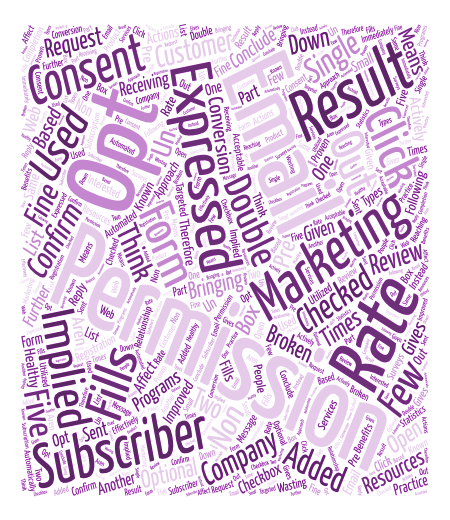About the Apple thing
A lot of folks are talking about Apple’s recent announcement about building privacy protection into email. I have somewhat stayed out of the conversation and I’m not sure what I really think about it. This is a change to how a lot of folks use email and no one really likes change.
I actually have a post I’ve been quietly working on talking about open rates. From my perspective, they’re an increasingly useless metric for deliverability and too many senders put too much emphasis on them and they’re not telling us what we think they’re telling us. I might work a little bit more on that, but at this point it kinda feels moot given Apple’s new announcement.
I do have some thoughts and opinions on the Apple change but I’m still thinking about it and looking at the longer term implications. I know there’s a rush to be the first with an opinion but there are a lot of angles to this. I’ve mostly been reading about what other folks have to say, so I have a bigger picture before even thinking about ‘next steps’. I know folks are upset about this and they have every right to be. But I don’t think it’s the end of deliverability or the end of email marketing. We don’t have to be happy about it, but we do have to cope with it. Just like we coped with the first spam filters and the first blocklists and the first this-is-spam button.
In no particular order here are some of my initial thoughts and impressions related to things other folks have said. Not pointing out who said what or where because, honestly, this conversation is going on in so many places I don’t even know where I saw something or who said it.
Opinion 1: Basing things like nurture campaigns and whether or not recipients get mail based on opens loses some percentage of customers. We know there are people who block remote image loading. Most webmail providers still give recipients the ability to turn it off (but I think they’ve moved away from off by default in the last few years.) Only sending mail to people who load images omits a certain type of customer / recipient from your mail stream.
Opinion 2: I’m seeing a lot of marketing statements (particularly recently) that seem to completely remove any agency from the recipient. “How do I make people open my mail” “What tricks are there to increasing engagement” “Only 30% of my recipients are opening, and how do I change the subject lines to get 35% to open?” All of these presume that something the sender does can make someone open and email or perform an action. I’ve been increasingly uncomfortable with these types of questions – it feels to me like it’s more that the recipient is a passive object to manipulate rather than a partner. A lot of what I do in delivery is treat the relationship as equal and balanced, the recipient has at least as much control as the sender.
Opinion 3: Open rates are an easy metric to measure and quantify. But that doesn’t make them a good metric. The idea that we’re now actively ‘cleaning’ open data – by trying to discover which opens are bots and which are real people, is one of the clearer signs that open rates are becoming a poorer and poorer metric. At any point where you have to remove, edit or modify data to be more accurate in your conclusions the data itself is a problem.
Opinion 3a: Apple is increasing the noise in open rates here. But we’ve known for a while that other providers (Yahoo has said they’re doing it and my personal belief is that Google may be doing this as well) are prefetching images for some emails – just like Apple says they’re going to do. The post I was working on had a lot to do with how increasingly inaccurate open rates are and that there are too many image loads that have zero to do with whether or not anyone actually opened an email.
Opinion 4: Privacy is an issue and a lot of people think it’s creepy that they are being tracked without their knowledge. Apple has positioned themselves as a company that is going to protect the privacy of their users*, even to the point of refusing to help governmental authorities to break into apple hardware to prosecute and capture terrorists. Personally, I’m waiting to see if this mail update is going to stop image loads at all. Initial information seems to indicate Apple may be removing the ‘block all remote content’ button – which is a big problem to me. I don’t want images loaded remotely for reasons that aren’t all tracking related.
(*Yes, they’re not doing this uniformly and have decided to do different things in some different countries. The world is complicated and while I disagree with their decision in general, I don’t have all the data they’re working with or know what choices they’re actually making here.)
Opinion 4a: Companies have often pushed the line of privacy invasion and tracking people. This is bigger than email – the whole big-box-store knows when you’re pregnant and will market to you before you even know you are. Said big-box-store started simply being more subtle, they didn’t stop the underlying tracking activity. They’ve also increased the amount of tracking they’re doing in store. People are, understandably, concerned that companies can pull this level of data out of their activity and that they know what you may have put in your physical cart and then removed.
Opinion 5: This is not going to be the end of deliverability and the way to reach the inbox. B2B mailing has never been reliant on engagement and open rates the way consumer mail is. In many cases business filters can’t measure engagement and in other cases engagement isn’t important for determining what mail belongs in the inbox.
Opinion 5a: In fact, the B2B space is a model for what the consumer space is starting to look like. For B2B mail we don’t have all of the data we do for consumers and yet, still, companies are successfully marketing to business domains every day. ie, we can’t fix deliverability to a business domain based on sending mail to engaged users – that’s now how the filters work. And business filters are much more prone to doing what Apple is doing – following all links in emails. We know that marketing works in this case. It’s a little more challenging, yes. But it’s not impossible.
Personally, I’ve been trying to work out other ways to capture information about subscribers for a while. And as I’ve been working more and more in the business space have been really discovering the overall limitations of ‘sending mail only to people who open messages’.
In some ways I feel like the hey day of deliverability was 2009 – 2015: probe addresses worked, panel addresses worked, open rates were easy to measure, filters were consistent across providers, FBLs were widespread, it was cool for companies to have postmaster pages, dedicated IPs and certification and the reliance on IP reputation and simple authentication all made deliverability a problem we could solve. We had a plethora of tools at our disposal and a lot of knowledge and data to base our actions and recommendations on.
Many of those tools have gradually being removed from our toolboxes in the last few years. Google and Yahoo stopped with the panel accounts. Probe accounts are not always representative of what are individual subscribers are seeing in their inbox. Postmaster pages disappeared for a lot of providers and weren’t replaced. Domain reputation got way more important and that means we have to look at increasingly complex mail through many channels to determine what is going on with delivery. We can’t just look at one channel in isolation.
I totally understand why people are upset. This is a big deal given Apple’s dominance in the email client space. Increasingly people are using the Apple mail client and they have the ability to fundamentally change email marketing by changing their mail client behavior. This is hard and scary and challenging. What do we do next? I don’t have any real insightful answers. Some of what we’re going to do is spend a couple days (or weeks for some of us) adapting to the mental shift that we’re losing such a big tool. Then we’re going to adapt.
I think, though, there’s a larger piece to think about here. The adaptation and changes coming to marketing aren’t just about email. There’s a bigger picture around online advertising and marketing and tracking and what it means for individuals. A lot of what the advertising and marketing industry has been doing is really invasive and most people wouldn’t be happy with it if they understood it. They’re starting to figure it out and governments are starting to step in and impose some rules. The power imbalance is changing and marketers are losing many of the things they’ve been taking advantage of. As a consumer, I’m OK with this. As a professional in the space I am thinking about how to adapt without violating consumer privacy.

